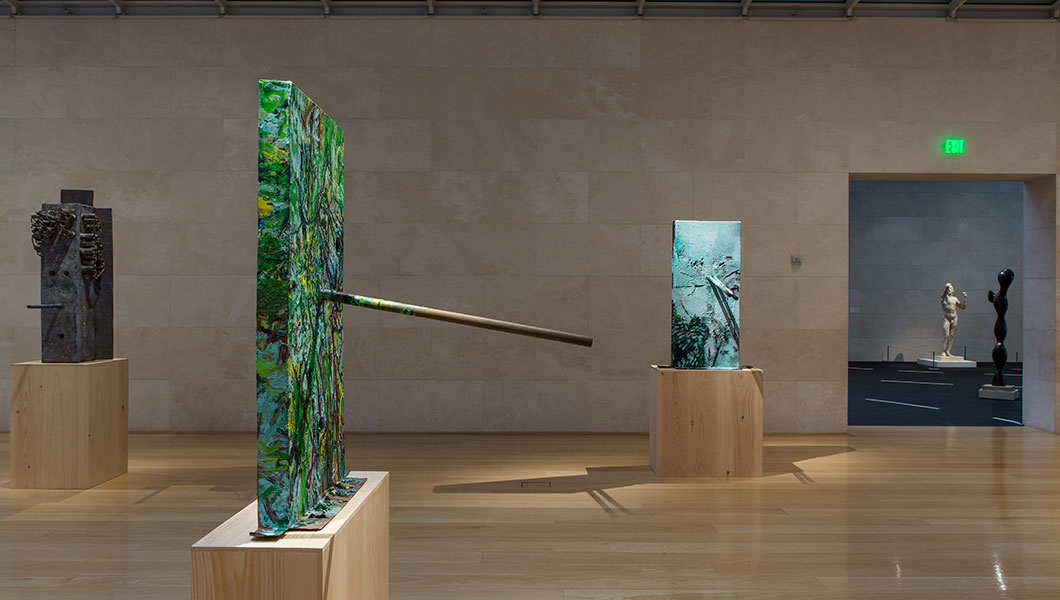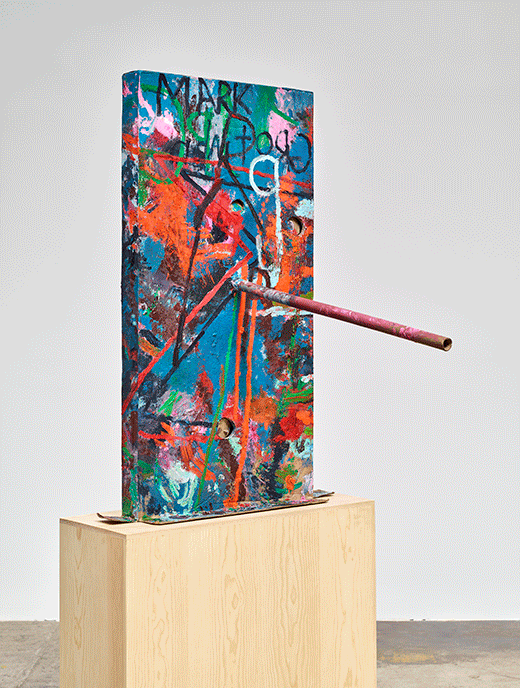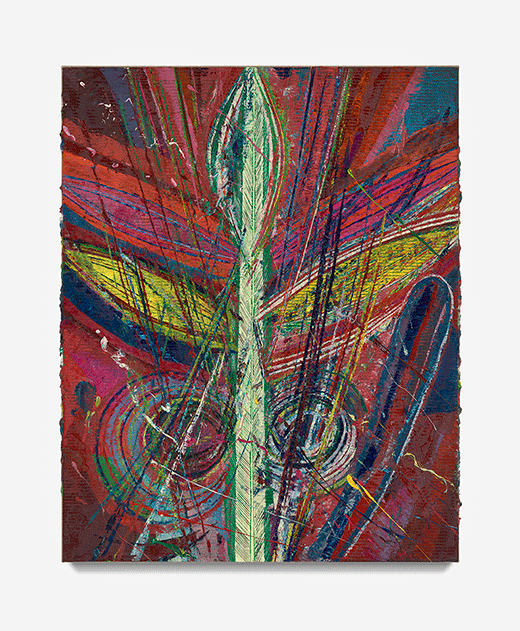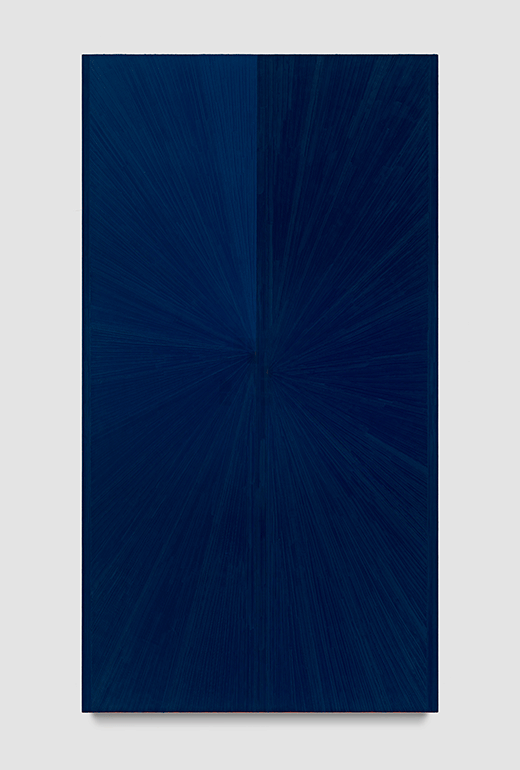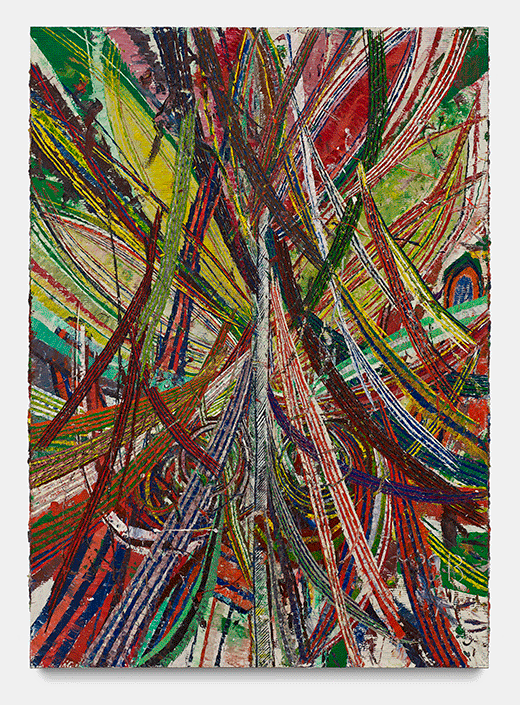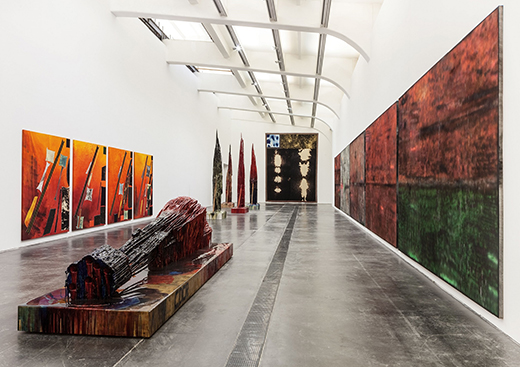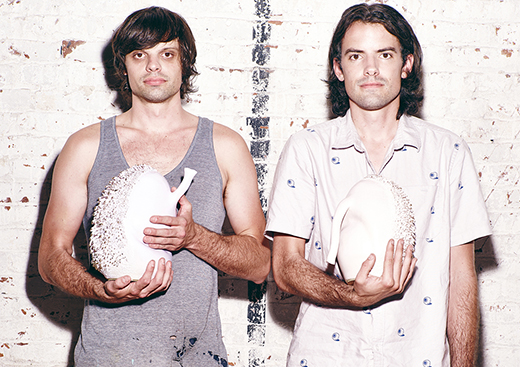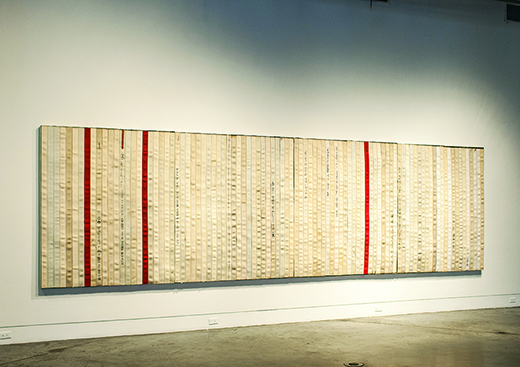FRANKLIN SIRMANS: It’s interesting—to me it seems like there’s always a sense of balance in your work. I’m just thinking about you going back and forth between painting and sculpture. Of course it’s all a painting practice, but I think that it must be something healthy in that feeling of connecting between the two.
MARK GROTJAHN: I don’t know if it’s healthy, I just know that I do better when I have a starting point. I do kind of need that. If I come to a studio and I don’t have a starting point I unravel a little bit.
FS: So how do you move between the work, then? Between, say, going into the studio and knowing, OK, this is a sculpture period.
MG: That’s something I do, I suppose; I go in and decide this is a sculpture period, I’ll be doing sculpture today. And then I’m going through a painting period, but sometimes when I’m going through a painting period I have a couple of sculptures in the painting studio. So if I need to take or want to take a break from the painting, I can go over to the sculpture and I could hit it and I can hit these paintings, hit the sculptures, a little bit at a time and then just walk away.
FS: Right.
MG: Which I really wish was also true for the “butterflies”—those I pretty much take from start to finish. I want to work on them whatever it is, 8- or 10-hour days until they’re done.
FS: That’s intense.
MG: But that’s not the case with the sculpture. In sculpture there’s just a lot more drawing time and layering, and sometimes it’s planned and sometimes it’s not and with the painting as well, I’m still just figuring out how to paint the sculptures.
FS: Uh-huh.
MG: So I may go in with an idea and it’s kind of like some impressionist-based thoughts, like clouds in the sky or some kind of Monet, Renoir, but filtered through abstract expressionism.
FS: Exactly.
MG: Then it just might turn out to be straight-out Kippenberger or something like that because I wasn’t able to pull it off.
FS: I love that balance. In some ways you can talk about it in the sort of landscape tradition that is based in representational imagery as much as in a more abstract space. I’m thinking of the Rothko-Newman kind of trajectory. Do you ever go back to older texts as a source of inspiration?
MG: Kandinsky wrote about it and that’s what I was reading when I was 15 and it was hugely important. I don’t go back to it—I’ve thought about doing that after I’ve read the text that Albers wrote on color and the color-theory plaque, but I don’t go to the text even in my head. I go to the paintings in my head.
FS: How did you come to Kandinsky at such an early age?
MG: Well, I always liked to draw, and I had a lot of learning difficulties, and I’d get tutored every day after school. I felt really really stupid. I had a lot of difficulty reading, so how does that relate? Well, I always did designs. I always liked doing designs, and a lot of them were symmetrical. I would get these weird mazes, a maze kind of a coloring book—that’s what I got from the tutoring. And I would do my own designs and then I’d just show them. I always thought of them as designs, like, “These are my designs.” And then I brought them to high school. I had this teacher and I showed them to her and she said, “Oh, have you ever looked at Kandinsky?” and I was like, “No.” So she showed me, she showed me the book The Spiritual in Art and then I started reading that and, you know, they talk about universal languages. I didn’t have any kind of conceptual backing to understand it, but it made a lot of sense to me, you know? But most importantly it gave a huge amount of validity to what I was doing as the potential of it to be something more …
FS: Are you going back to the butterflies at all? Have you thought about them recently?
MG: Butterflies have been taken off the table when I broke my shoulder. I would have liked to explore the monochrome paintings longer. I’d like to go back into that and see what I could do there, but I don’t know if I could ever make another butterfly, if I even had the patience to relearn that skill.
FS: What draws you to the monochrome aspect of that, because with the butterflies you could see where the design idea sort of meets up with abstraction and with the monochrome—is it more about an exploration of colors?
MG: For the most part the butterflies weren’t exactly monochrome.
FS: They’re close.
MG: Every triangle was different. I used a different color, but if you look at it from a distance it basically looks like one color or it looks like it slowly changes color as it goes counterclockwise, or clockwise if I painted it as clockwise … so yeah, it would be the study of color.
FS: Right.
MG: I love slight color change. I love that and I love looking at a monochrome.
FS: So do I.
MG: And with the design that I was working within that motif, it just satisfied everything. It was similar to the way that Mondrian worked.
FS: Yeah.
MG: But filled with these right angles and the colors, you know, it was regimented. And then with that there was just so much freedom; I just get so excited at really good monochromes.
FS: Absolutely. So I have a couple of rogue questions.
MG: Shoot.
FS: Do you think about an audience for your work? Do you think there’s a specific audience?
MG: Well, while I’m preparing for a show I think about creating a stage that feels great for people to come into, so I think about what does it feel like. That doesn’t mean that I’m trying to figure out what they want and do it. I want to figure out what I want, what I think makes for the best experience of a room, the best experience of the work in that room.
FS: Yeah.
MG: So you’ve got the work, you’ve got the room, so it’s about where those two things meet and how does the relationship work between them. If I’m doing a series of paintings that I know is going to go to a specific show, definitely at some point that starts to play into it.
FS: In the last couple of years, there’s been so much conversation about abstraction—how do you feel about or do you even think about this kind of stuff?
MG: Sometimes I see some people that are making paintings that are interesting. And that’s always really exciting; there’s always people making good work. I don’t know where that work is being made always or who’s making it but I know that somebody out there. I draw a difference between abstraction and non-objective painting.
FS: Right. Is it harder now? I think in some ways the best thing that I find about painting in general is that tightrope that you walk between something that is recognizable and something that is not and creating a space where me as a viewer can go in many different directions based upon the experiences that I come to in the work.
MG: That seems good to me. I’m OK with both the verging on representational and non-representational, and I’m also OK with straight-out non-objective. I like it all, you know, it just depends, as long as it’s rigorous.
FS: Yeah.
MG: I like it when it’s hardcore—how else would you say that and not sound too pretentious? Does “rigorous” sound better in an interview?
FS: I’ll try to figure out the best.
MG: If I’m reading that in like a magazine and it says “hardcore,” you know, it’s like what the fuck?
FS: I know. I think it depends on the words that are around it.
MG: Right.
FS: I was also interested in thinking about background. We talked about Albers, Kandinsky and Mondrian, but are there artists in our generation that you respond to?
MG: In our generation? Does that mean 40 to 50?
FS: Yeah, I’m right there with you.
MG: 40-to-50 age group, I think Mary Weatherford has been making some really great paintings.
FS: Yeah, me too.
MG: Those are exciting, and I really like Ivan Morley’s work and Tauba Auerbach,
I really like her work. I like her Fold paintings.
FS: Yeah.
MG: I mean, the way she installs her Fold paintings.
FS: Absolutely.
MG: It’s glorious. And then occasionally I get the opportunity to see some of Kai Althoff’s paintings—it’s crazy what he is doing. It’s surreal, like Gustav Klimt. Those are exciting. And then Tomma Abts—there is a lot of talent.
FS: Do you work at home and in the studio or just in the studio?
MG: I only work in the studio. I lived in my studio for a long time, so I did that. And that was useful.
FS: It’s work, right? You mentioned before 9 to 5?
MG: Yes, I’m a 9-to-5er, for sure.
FS: I have to ask, what’s up with your Instagram? Your Instagram has been amazing. What are you doing? I can’t figure it out.
MG: Well, Instagram has really freed me up, totally freed me up, in a way that is part of my art. It’s freed me to write, it’s a place—it’s another little studio you can have to do whatever you want.
FS: But obviously the audience is different and the expectation is different, so you can talk in different ways. I think it’s a great space to explore.
MG: I do a lot of posts. I think a lot of people don’t follow me because I clog up their feed.
FS: You do post pretty frequently—it’s awesome. So that’s really it … I’m really happy you could do this.
MG: Thank you.
FS: I really appreciate it, Mark.
MG: Glad we got a chance to do it.
—


